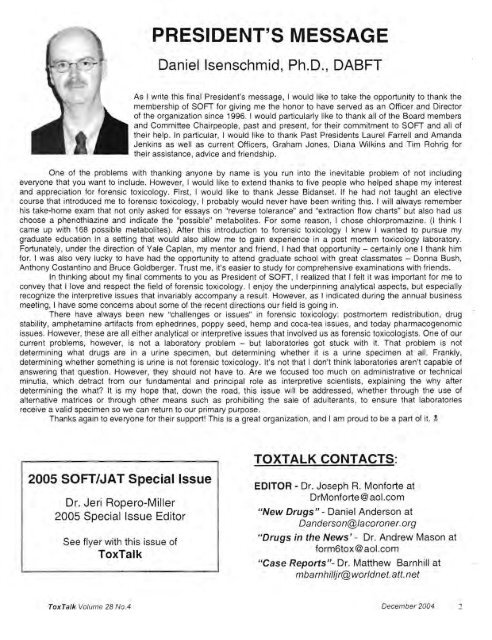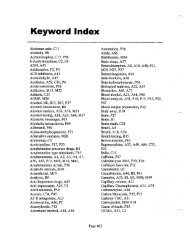ToxTalk Volume 28-4 - Society of Forensic Toxicologists
ToxTalk Volume 28-4 - Society of Forensic Toxicologists
ToxTalk Volume 28-4 - Society of Forensic Toxicologists
Create successful ePaper yourself
Turn your PDF publications into a flip-book with our unique Google optimized e-Paper software.
PRESIDENT.S MESSAGE<br />
Daniel Isenschmid, Ph.D., DABFT<br />
As I write this final President's message, I would like to take the opportunity to thank the<br />
membership <strong>of</strong> SOFT for giving me the honor to have served as an Officer and Director<br />
<strong>of</strong> the organization since 1996. I would particularly like to thank all <strong>of</strong> the Board members<br />
and Committee Chairpeople, past and present, for their commitment to SOFT and all <strong>of</strong><br />
their help . In particular, I would like to thank Past Presidents Laurel Farrell and Amanda<br />
Jenkins as well as current Officers, Graham Jones, Diana Wilkins and Tim Rohrig for<br />
their assistance, advice and friendship.<br />
One <strong>of</strong> the problems with thanking anyone by name is you run into the inevitable problem <strong>of</strong> not including<br />
everyone that you want to include. However, I would like to extend thanks to five people who helped shape my interest<br />
and appreciation for forensic toxicology. First, I would like to thank Jesse Bidanset. If he had not taught an elective<br />
course that introduced me to forensic toxicology, I probably would never have been writing this. I will always remember<br />
his take-home exam that not only asked for essays on "reverse tolerance" and "extraction flow charts" but also had us<br />
choose a phenothiazine and indicate the "possible" metabolites. For some reason , I chose chlorpromazine. (I think I<br />
came up with 168 possible metabolites). After this introduction to forensic toxicology I knew I wanted to pursue my<br />
graduate education in a setting that would also allow me to gain experience in a post mortem toxicology laboratory.<br />
Fortunately, under the direction <strong>of</strong> Yale Caplan, my mentor and friend, I had that opportunity - certainly one I thank him<br />
for. I was also very lucky to have had the opportunity to attend graduate school with great classmates - Donna Bush,<br />
Anthony Costantino and Bruce Goldberger. Trust me, it's easier to study for comprehensive examinations with friends.<br />
In thinking about my final comments to you as President <strong>of</strong> SOFT, I realized that I felt it was important for me to<br />
convey that I love and respect the field <strong>of</strong> forensic toxicology. I enjoy the underpinning analytical aspects, but especially<br />
recognize the interpretive issues that invariably accompany a result. However, as I indicated during the annual business<br />
meeting, I have some concerns about some <strong>of</strong> the recent directions our field is going in.<br />
There have always been new "challenges or issues" in forensic toxicology: postmortem redistribution, drug<br />
stability, amphetamine artifacts from ephedrines, poppy seed, hemp and coca-tea issues, and today pharmacogenomic<br />
issues. However, these are all either analytical or interpretive issues that involved us as forensic toxicologists. One <strong>of</strong> our<br />
current problems, however, is not a laboratory problem - but laboratories got stuck with it. That problem is not<br />
determining what drugs are in a urine specimen, but determining whether it is a urine specimen at all. Frankly,<br />
determining whether something is urine is not forensic toxicology. It's not that I don't think laboratories aren't capable <strong>of</strong><br />
answering that question. However, they should not have to. Are we focused too much on administrative or technical<br />
minutia, which detract from our fundamental and principal role as interpretive scientists, explaining the why after<br />
determining the what It is my hope that, down the road, this issue will be addressed, whether through the use <strong>of</strong><br />
alternative matrices or through other means such as prohibiting the sale <strong>of</strong> adulterants, to ensure that laboratories<br />
receive a valid specimen so we can return to our primary purpose .<br />
Thanks again to everyone for their support! This is a great organization, and I am proud to be a part <strong>of</strong> it. ~<br />
2005 SOFT/JAT Special Issue<br />
Dr. Jeri Ropero-Miller<br />
2005 Special Issue Editor<br />
See flyer with this issue <strong>of</strong><br />
<strong>ToxTalk</strong><br />
TOXTALK CONTACTS:<br />
EDITOR - Dr. Joseph R. Monforte at<br />
DrMonforte@aol.com<br />
"New Drugs" - Daniel Anderson at<br />
Oanderson@lacoroner.org<br />
"Drugs in the News' - Dr. Andrew Mason at<br />
form6tox@aol.com<br />
"Case Reports"- Dr. Matthew Barnhill at<br />
mbarnhi/ljr@worldnet.aft.net<br />
<strong>ToxTalk</strong> <strong>Volume</strong> <strong>28</strong> No.4 December 2004
















